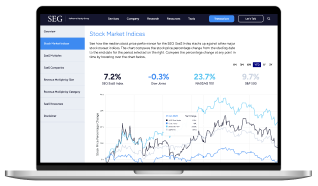SEG’s Chief Industry Strategist, Technologist, and Evangelist, Paul LaChance, presents insights on the state of the Industrial & Manufacturing sector. The presentation begins with an analysis of current sector data and trends, followed by an overview of the SaaS industry, and concludes with insights on sector-specific M&A activity and its impact on strategic decisions.
TRANSCRIPTION
Industry Headwinds and Tailwinds
{Paul Lachance:} The Purchasing Managers Index serves as a crucial indicator of the manufacturing sector’s health, reflecting monthly fluctuations influenced by a myriad of global events. From trade wars to pandemics, the sector faces an array of challenges, including labor shortages, supply chain disruptions, and inflationary pressures. Despite these hurdles, technological advancements, particularly in SaaS applications, offer manufacturers a lifeline. These technologies provide adaptive solutions to navigate turbulent times, optimize operations, mitigate risks, and enhance resilience. By leveraging technology, manufacturers can not only weather uncertainties but also seize opportunities for growth amidst adversity.
Legislative Impacts & Reshoring Initiatives
{Paul Lachance:} Recent legislative initiatives aim to bolster domestic manufacturing through reshoring and onshoring efforts. These measures, responding to supply chain vulnerabilities exposed by global events, seek to enhance the sector’s competitiveness. Despite challenges such as workforce shortages and cost constraints, investments in technology, notably in SaaS solutions, drive sustainable growth and resilience. The legislative landscape, coupled with technological advancements, fosters an environment conducive to innovation and revitalization in the manufacturing sector. By capitalizing on legislative support and embracing digital transformation, manufacturers can position themselves for long-term success in an ever-evolving market landscape.
Embracing Digital Transformation
{Paul Lachance:} Digital transformation in manufacturing transcends mere technology adoption; it represents a fundamental shift in operational paradigms. Moving from Industry 3.0 to 4.0 entails leveraging data-centric approaches, artificial intelligence, and the IoT to optimize processes and decision-making. The concept of a Unified Namespace, integrating data across systems, facilitates predictive analytics and prescriptive operations. This empowers organizations to enhance efficiency and adaptability, unlocking new avenues for growth and competitiveness. As manufacturers embrace digitalization, they not only future-proof their operations but also drive innovation and sustainable development in the sector.
Dissecting the P-F Curve
{Paul Lachance:} Efficient maintenance engineering is paramount for maximizing asset performance and minimizing disruptions in manufacturing operations. Proactive approaches such as condition-based monitoring and predictive maintenance, enabled by SaaS technologies, offer significant benefits. By adopting these strategies, organizations can push up the P-F curve, delaying functional failures and reducing maintenance costs. A unified data architecture ensures seamless data flow, facilitating informed decision-making and operational optimization. Maintenance engineering plays a pivotal role in ensuring operational excellence and competitiveness in the manufacturing sector. By investing in technological solutions, manufacturers can streamline maintenance processes, optimize asset utilization, and drive continuous improvement across their operations.
Exploring the SaaS Landscape
{Paul Lachance:} The SaaS landscape in manufacturing comprises a diverse range of solutions tailored to industry needs. From automation control to asset management and regulatory compliance, specialized platforms address specific challenges faced by manufacturers. As organizations embrace digitalization, there’s a growing emphasis on industrial data ops and the unified namespace concept. These facilitate efficient data management and operational optimization, empowering manufacturers to enhance productivity and streamline processes. By leveraging SaaS solutions, manufacturers can adapt to evolving market demands, drive innovation, and maintain a competitive edge in the global marketplace.
LEARN MORE: To see the key players in this sector, view SEG’s Market Map.
Insights into Mergers and Acquisitions
{Paul Lachance:} Mergers and acquisitions in the Industrial & Manufacturing sector reflect shifting trends, with private equity playing a dominant role in deal flows. This trend underscores investor confidence in the sector’s resilience and potential for growth. Strategic investments in technologies supporting operational excellence, such as those enabling PF curve optimization, yield favorable outcomes for both manufacturing organizations and investors alike. By focusing on innovation and efficiency, companies can position themselves for success in an evolving market landscape. With private equity firms increasingly recognizing manufacturing as a safe and durable investment, M&A activity is expected to continue driving growth and transformation in the sector.






